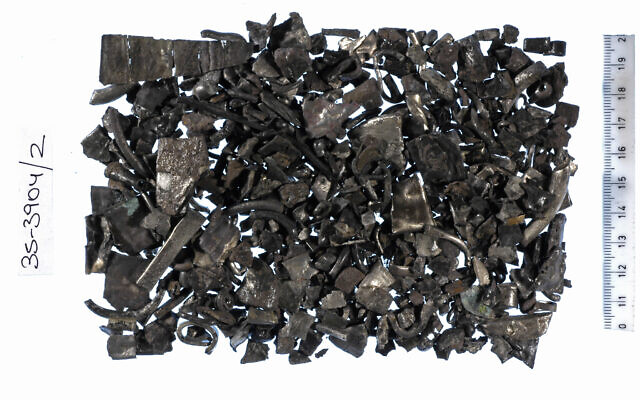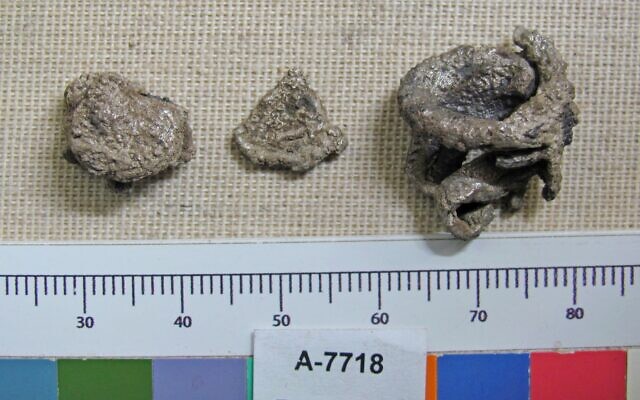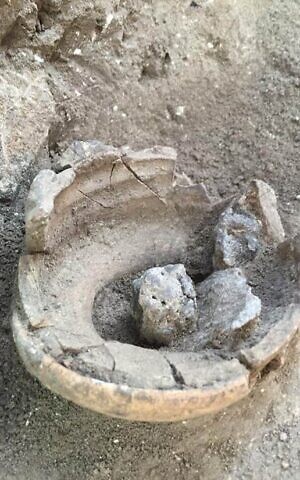3,600-year-old hoards may contain the earliest silver currency in Israel and Gaza

A team of Israeli archaeologists has discovered the earliest evidence of silver being used as currency in the Levant, dating back more than 3,600 years, which is 500 years prior to previous estimates.
“This is the earliest evidence of hoarded silver,” the University of Haifa’s Dr. Tzilla Eshel told The Times of Israel.
Uncovered in excavations around Israel and the Gaza Strip, the proto-coinage’s silver dates to the Middle Bronze Age and originated in either ancient Anatolia or in the area of ancient Greece, researchers from the University of Haifa and Hebrew University said on Sunday.
“This means that we are witnessing the first evidence that there was continuous and long-term trade of metals between the Levant and Anatolia, already 1,700 years before the common era,” said Eshel. “We know for sure that in the Iron Age this kind of trade existed, but our findings move the beginning of this type of trade in metals to 500 years earlier,” she said.
The discovery, published in the Journal of Archaeological Science, shows that ancient cities in the region had a much more developed long-distance trade relationship and local economy than previously believed.
The silver hoards were found in Israel’s Megiddo, Gezer and Shiloh, as well as Tel el-‘Ajjul in the Gaza Strip. Their different origins were discovered through isotope analysis. The current study also examined previously discovered samples from the Israel Antiquities Authority, the Rockefeller Museum, and the New Orleans Baptist Theological Seminary.

“The use of silver [as currency] indicates a society that used scales, and indicates a society that used writing to write down the transactions,” explained Eshel. “It also means you need to have silver flowing into the area constantly, so the volume of trade has to be larger, and you can see something bigger is happening in economic terms.”
People in the Levant didn’t begin using minted coins until almost 1,000 years after these pieces of broken silver were used as currency, said the researchers. For major purchases, these crudely cut pieces of silver acted as currency through the weight of the precious metal.
“Before there were coins there were a kind of proto-coins. In fact, people, before they would make coins, they first used the idea of taking silver, breaking it up into pieces and weighing them on a scale or balance,” then-head of the Israel Antiquities Authority coin department Donald Ariel told The Times of Israel in a video interview in 2020. “They are lumps of broken jewelry,” said Ariel.
The silver hoards are what is called hacksilber, a German term that means silver that has been cut to specific weights. The team of researchers determined that the fact that there were multiple hoards of these hacksilber discovered throughout the Holy Land — sometimes inside pottery or wrapped in fabric — pointed to the fact that they were widely used.
In fact, the biblical currency of the “shekel” was originally a weight measurement. According to the Babylonians, 1 shekel was approximately 16.83 grams.
“This is the way Abraham paid for the Cave of the Patriarchs — he weighed 400 shekels. There were no coins at the time. He weighed pieces of silver,” said Ariel.
Follow the silver brick road
There were no known silver mines in the Levant, so researchers set out to determine where the pieces of silver originated. Using isotopic testing that examines the chemical composition of lead in the silver, the researchers were able to match it to silver mined from an area in Anatolia, or modern-day Turkey. In the excavated hoards, the silver was also accompanied by other objects from Anatolia, such as the head of an ax and a pendant, confirming Anatolia as the likely origin of the silver.
Eshel calls isotopic testing “an amazing and very powerful tool,” which allowed researchers to pinpoint the geographic area where the silver was likely mined based on its unique chemical composition. She noted that the test isn’t always conclusive and there are some academic debates about its implementation. In some cases researchers can pinpoint the exact spot where a silver object was mined, though the current findings confirmed a more general geographic region.

“Before, archaeologists tracked trade routes using ceramics, but not every trade route has ceramic evidence,” Eshel said. “This is the first time we are doing it for silver in the Bronze Age.”
Silver first reached the Levant in the 4th millennium BCE, used for figurines and jewelry. Only in the Bronze Age, in the 3rd millennium BCE, were pieces of silver used as currency, Eshel said.
“We know that the silver was the main means of value and exchange in Mesopotamia for a long time, even before the Levant,” explained Eshel. “Everything was valued by silver shekel.”
Because silver was so precious, it was only used for large purchases, such as land. Day-to-day currency more likely used grain, pegged to the shekel weight, such as 2 shekels for a bag of grain, noted Eshel. Eshel said she read that a half gram of silver was equal to a day and a half of work.

Eshel said that hacked silver is often overlooked by archaeologists because it’s fairly ugly. Oftentimes, such as at Tel el-Ajjul in Gaza near the Egyptian border, hacksilber is found with more beautiful or flashier objects that hold more attention. But Eshel said that the irregular lumps of silver can reveal just as much, if not more, about daily life in the ancient Levant.
“This raw material doesn’t have a nice shape and doesn’t look so great in photos,” she said. “But I think it’s beautiful.”